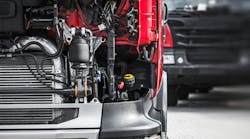Each fleet sets its trade cycles, with some keeping their trucks for just a few years and others opting for longer tenures. But whether a fleet keeps a truck for four years or 10, each fleet expects the equipment to operate efficiently during its useful life.
Ensuring that a truck performs optimally throughout its useful life depends on two key elements—proper spec’ing and proper maintenance.
To get the most out of a vehicle, it must be spec’d for its intended use. Before spec’ing a truck, review how it will be used. Things to consider are miles traveled per day/week/month, terrain it will be operating in, weights it will carry, weather conditions in the area it operates, etc. You must also review powertrain options to determine which engine type is best suited for the application.
You’ll also want to include safety-related items in your spec and any driver amenities to help you in your recruiting and retention efforts. I suggest you complete a thorough spec review before ordering vehicles. This will help ensure the vehicle specs match the unit’s duty cycle.
See also: How maintenance parts purchases impact fleet profits
During the spec’ing process, seek input from drivers and technicians. Drivers can tell you what is working well, what isn’t, and what makes the truck challenging to drive. Technicians can give you input on components, parts, or brands that complicate repairs or extend repair time. While you can’t necessarily comply with every comment or request, talking to drivers and technicians will give you valuable insights that should be considered.
Once a vehicle is spec’d properly, the next step is to set up an ongoing schedule for preventive maintenance service. Use the manufacturer’s recommendations as a starting point and tweak the schedule to reflect your use case. For vehicles operating in harsh environments, you may need to bring them in for maintenance more frequently.
Your next step is to collect data on the asset based on preventive maintenance inspections, unscheduled service events, and on-road breakdowns. This data gives insight into how the asset performs and allows you to identify problem areas.
For similarly spec’d assets, aggregating the data will allow you to spot trends surrounding asset performance. This will enable you to proactively bring assets into the shop and fix a problem before it results in an on-road breakdown.
The service history data you collect also can be used to inform future spec’ing decisions. If a particular component is not performing as expected in a certain application, you can look at spec’ing a more robust option on the next order or perhaps consider switching suppliers for that particular component.
The combination of a purpose-built asset spec’d for its intended use and a maintenance schedule that matches the duty cycle will allow you to operate the asset throughout its useful life no matter how long that is.
Gino Fontana, CTP, is COO and EVP at Transervice Logistics Inc. Prior to this, he was VP of operations at Berkeley Division and Puerto Rico. He has more than 35 years of experience in the transportation and logistics industry with both operational and sales experience.



